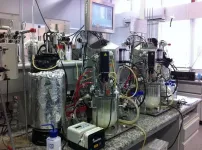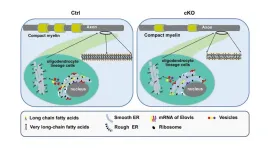(Press-News.org) A Brazilian study paves the way to increased efficiency of second-generation (2G) ethanol production based on the discovery of novel targets for metabolic engineering in a more robust strain of industrial yeast. An article on the study is published in the journal Scientific Reports.
The databases compiled by the authors are at the disposal of the scientific community in the repository of the State University of Campinas (UNICAMP), which is a member of the Dataverse Project, an international collaborative initiative supported by FAPESP.
First-generation (1G) ethanol is produced from sources rich in carbohydrates (such as sucrose), especially sugarcane in the Brazilian case. Processing of sugarcane generates large amounts of fibrous residues, such as bagasse, which can be used to produce steam and electricity in power plants. These residues are rich in cellulose and hemicellulose (polymeric carbohydrates that maintain the mechanical strength of plant stem cell walls), which can be used to produce 2G ethanol via conversion into smaller molecules for fermentation by yeast and other microorganisms.
The main challenge in 2G ethanol production is conversion efficiency since cellulose and hemicellulose are hard to hydrolyze. The first step has to be the removal of tough, stringy lignin, which is basically fiber, to make the simple sugars located in the cellulose and hemicellulose available to the yeast. This is costly, consumes a great deal of energy, and releases substances that can inhibit the fermentation process.
“2G ethanol production still requires optimization to increase efficiency. One of the approaches needed entails the identification of yeast strains that resist spoilage by inhibitory molecules derived from the processing of these residues,” said Marcelo Mendes Brandão, last author of the article and a researcher at UNICAMP’s Center for Molecular Biology and Genetic Engineering (CBMEG). “Some industrial yeast strains are known to have higher levels of tolerance of these compounds. A well-documented example is Saccharomyces cerevisiae SA-1, a Brazilian industrial strain for fuel ethanol that has shown high resistance to inhibitors produced by the pretreatment of cellulosic complexes. This strain was the focus of our study.”
The analysis was in line with a Thematic Project supported by FAPESP. The principal investigator was Telma Franco, a professor at UNICAMP’s School of Chemical Engineering.
The research group also received funding from FAPESP via four other projects (18/17172-2, 11/00417-3, 18/01759-4 and 19/13946-6).
Methods
The experiments were performed by first and second authors Felipe Eduardo Ciamponi and Dielle Pierotti Procópio, both of whom were PhD candidates at the time, in a collaboration involving the laboratory led by Thiago Olitta Basso, a researcher at the Department of Chemical Engineering of the University of São Paulo’s Engineering School (POLI-USP), and Brandão’s lab at CBMEG-UNICAMP.
“To put this study in the context of research on 2G ethanol, we knew certain strains of S. cerevisiae were resistant to these inhibitors, but the molecular mechanism they use to achieve this resistance is complex, involving multiple processes and regulatory pathways,” Basso said. The study focused on p-Coumaric acid (pCA), one of the main inhibitors present in sugarcane bagasse after processing. “The data available in the literature shows that pCA inhibits biomass yield and lowers the performance of this yeast strain in 2G ethanol production.”
To understand how the yeast responded to the culture medium, the researchers decided to use a multiomics-based approach combined with bioinformatics to integrate analysis of the transcriptome – the full range of messenger RNA (mRNA) molecules expressed by the organism – with quantitative physiological data. Their aim was to arrive at a molecular and physiological characterization of the yeast’s response to this key inhibitor.
Procópio and Ciamponi conducted the biological experiments at POLI-USP’s BioProcessing Laboratory (BELA) using continuous culturing in chemostats, a type of bioreactor in which the physiological and chemical conditions are tightly controlled, enabling them to isolate transcriptomic alterations that arose in response to the presence of pCA without interference from other variables influenced by environmental conditions.
Samples of steady-state S. cerevisiae SA-1 cultured in anaerobic chemostats with and without pCA were collected to determine physiological parameters. Part of the material was sent to Taiwan for RNA sequencing. The results, which were analyzed at CBMEG-UNICAMP’s Integrative Systems Biology Laboratory, showed that the biological mechanisms used by the yeast strain to survive under the influence of this inhibitor are even more intricate than previously thought.
The quantitative physiological data suggested that the yeast tended to increase sugar and ethanol yield when exposed to pCA stress under anaerobic conditions (relevant to the industrial process).
Brazil has advanced in research on ways of leveraging its outstanding biodiversity to optimize biomass yields in the manufacturing of bioproducts – consumer goods that can be built, assembled or produced by converting part of an organism, as in the case of plant tissue and fiber, or by capturing their metabolites. “An example is production of fuel ethanol, a commodity with significant impact on the Brazilian economy,” Brandão said.
About São Paulo Research Foundation (FAPESP)
The São Paulo Research Foundation (FAPESP) is a public institution with the mission of supporting scientific research in all fields of knowledge by awarding scholarships, fellowships and grants to investigators linked with higher education and research institutions in the State of São Paulo, Brazil. FAPESP is aware that the very best research can only be done by working with the best researchers internationally. Therefore, it has established partnerships with funding agencies, higher education, private companies, and research organizations in other countries known for the quality of their research and has been encouraging scientists funded by its grants to further develop their international collaboration. You can learn more about FAPESP at www.fapesp.br/en and visit FAPESP news agency at www.agencia.fapesp.br/en to keep updated with the latest scientific breakthroughs FAPESP helps achieve through its many programs, awards and research centers. You may also subscribe to FAPESP news agency at http://agencia.fapesp.br/subscribe.
END
Study paves way to more efficient production of 2G ethanol using specially modified yeast strain
Brazilian researchers identified the genes that make the industrial yeast strain Saccharomyces cerevisiae SA-1 resistant to fermentation inhibitors generated during sugarcane bagasse preprocessing.
2023-03-27
ELSE PRESS RELEASES FROM THIS DATE:
UC Davis Health collaborates with Propeller Health to improve clinical outcomes of COPD patients
2023-03-27
UC Davis Health and Propeller Health have announced a new collaboration that will offer personalized treatment for high-risk patients with asthma and chronic obstructive pulmonary disease (COPD) aiming to improve their health outcomes.
As part of the collaboration, UC Davis Health will provide the Propeller program – including sensors, mobile app, web portal, and personalized support – to eligible patients, with eventual expansion to patients in other UC locations and UC affiliates. The sensors attach to a patient’s inhaler to capture unique signals that record events, such as ...
Largest study to date of minipuberty identifies two new patterns of the reproductive hormone, AMH, in infant girls
2023-03-27
Minipuberty is a stage of reproductive development during infancy in both sexes when reproductive hormones change and reproductive organs develop. The importance of minipuberty is not well understood but could represent an opportunity for the early identification of future reproductive conditions and enable prompt treatment. Anti-Müllerian hormone (AMH) is one of the hormones that changes during minipuberty, and it plays a key role in the development of reproductive organs in boys. However, the role of AMH in infant girls is less clear.
In ...
Bomb-sniffing rodents undergo ‘unusual’ reproductive transformations
2023-03-27
ITHACA, N.Y. – Female giant African pouched rats, used for sniffing out landmines and detecting tuberculosis, can undergo astounding reproductive organ transformations, according to a new study.
The paper, “Extreme plasticity of reproductive state in a female rodent,” which published March 27 in Current Biology, explores how traits once considered “fixed” in adult animals may become variable under specific pressures.
Though these rodents could have important military, biodetection and humanitarian uses, breeding them at high rates has been a challenge. ...
ENGOT-EN6-NSGO/GOG-3031/RUBY trial results: The new standard of care in advanced/recurrent endometrial cancer
2023-03-27
EMBARGO DATE: Monday, March 27, 2023, 12:30 pm ET
PRESS RELEASE
ENGOT-EN6-NSGO/GOG-3031/RUBY trial results:
The new standard of care in advanced/recurrent endometrial cancer
ENGOT, NSGO-CTU & GOG-Foundation proudly announce the ground-breaking results of ENGOT-EN6-NSGO/GOG-3031/RUBY trial.
The results reveal improvement in overall survival at 24 months in whole study population from 56% (CP+placebo) to 71.3% (CP+dostarlimab). “although these are interim data, we believe they are robust and will be confirmed with longer follow-up.”, said Mansoor R Mirza.
The trial is presented on 27th of March 2023 through ESMO’s ...
Human body a breeding ground for antimicrobial resistance genes
2023-03-27
The community of microbes living in and on our bodies may be acting as a reservoir for antibiotic resistance, according to new research from the Earlham Institute and Quadram Institute in Norwich.
The use of antibiotics leads to ‘collateral damage’ to the microbiome, ramping0 up the number of resistance genes being passed back and forth between strains in the microbiome.
The findings also suggest these genes spread so easily through a population that, regardless of your own health and habits, the number of resistance genes in your gut is heavily influenced by national trends in antibiotic consumption.
The rise of antimicrobial resistance (AMR) among human pathogens is widely seen ...
U of I study gives a thumbs up to carefully formulated vegan diets for dogs
2023-03-27
URBANA, Ill. – In today’s pet food market, there are products to match nearly every lifestyle, value system, and price point pet owners demand, including vegan formulations. New University of Illinois research shows at least two human-grade, lightly cooked vegan diets provide adequate nutrition for dogs.
“The trends of vegan foods and human grade foods are increasing for dogs. Because people are feeding these diets to their pets, it’s important they be tested like all other foods to make sure they're safe and ‘complete and balanced,’” ...
Epstein-Barr virus associated tumors and drug repurposing
2023-03-27
A new study published in the peer-reviewed OMICS: A Journal of Integrative Biology identified differentially expressed host and viral microRNAs (miRNAs) in six Epstein-Barr virus (EBV) associated tumors. The study reports several drug candidates for repurposing and targeting EBV latent infection: Glyburide, Levodopa, Nateglinide, and Stiripentol, among others. Click here to read the article now.
The authors, Anamika Thakur and Manoj Kumar, PhD, from the Institute of Microbial Technology, Council of Scientific and Industrial Research (CSIR), Chandigarh, India, note: “This is the first integrative analysis, to the best of our knowledge, in regard to the potential ...
Researchers identify 6 challenges humans face with artificial intelligence
2023-03-27
ORLANDO, March 27, 2023 - A University of Central Florida professor and 26 other researchers have published a study identifying the challenges humans must overcome to ensure that artificial intelligence is reliable, safe, trustworthy and compatible with human values.
The study, “Six Human-Centered Artificial Intelligence Grand Challenges,” was published in the International Journal of Human-Computer Interaction.
Ozlem Garibay ’01MS ’08PhD, an assistant professor in UCF’s Department ...
Mea6 deficiency in oligodendrocytes affects white matter formation in the brain
2023-03-27
More than half amount in adult human brain is made up of white matter. Lipid-rich myelin is a special structure formed by oligodendrocytes wrapping neuronal axons to form the major components of white matter. Abnormal myelin sheath is associated with many neurological diseases. Mea6/ cTAGE5C is essential for vesicle trafficking from ER to Golgi. However, its biological function in oligodendrocyte and white matter development remains unclear.
Scientists from Institute of Genetics and Developmental Biology of Chinese Academy of Sciences generated mice with conditional knockout (cKO) of Mea6 in oligodendrocytes. Using ...
Massively effective filter for topology optimization based on the splitting of tensor product structure
2023-03-27
Recently, a research group lead by Prof. Shuting Wang from topology optimization of Huazhong University of Science and Technology has put forward a massively efficient filter utilizing the splitting of the tensor product structure. This study can be found in the journal Frontiers of Mechanical Engineering on 10 January, 2023.
With the aid of spitting technique, the traditional weight matrices of both B-splines and non-uniform rational B-splines implicit filters are equivalently decomposed into two or three submatrices, by which the sensitivity analysis is reformulated for the nodal design variables without altering ...
LAST 30 PRESS RELEASES:
SIMJ announces global collaborative book project in commemoration of its 75th anniversary
Air pollution exposure and birth weight
Obstructive sleep apnea risk and mental health conditions among older adults
How talking slows eye movements behind the wheel
The Ceramic Society of Japan’s Oxoate Ceramics Research Association launches new international book project
Heart-brain connection: international study reveals the role of the vagus nerve in keeping the heart young
Researchers identify Rb1 as a predictive biomarker for a new therapeutic strategy in some breast cancers
Survey reveals ethical gaps slowing AI adoption in pediatric surgery
Stimulant ADHD medications work differently than thought
AI overestimates how smart people are, according to HSE economists
HSE researchers create genome-wide map of quadruplexes
Scientists boost cell "powerhouses" to burn more calories
Automatic label checking: The missing step in making reliable medical AI
Low daily alcohol intake linked to 50% heightened mouth cancer risk in India
American Meteorological Society announces Rick Spinrad as 2026 President-Elect
Biomass-based carbon capture spotlighted in newly released global climate webinar recording
Illuminating invisible nano pollutants: advanced bioimaging tracks the full journey of emerging nanoscale contaminants in living systems
How does age affect recovery from spinal cord injury?
Novel AI tool offers prognosis for patients with head and neck cancer
Fathers’ microplastic exposure tied to their children’s metabolic problems
Research validates laboratory model for studying high-grade serous ovarian cancer
SIR 2026 delivers transformative breakthroughs in minimally invasive medicine to improve patient care
Stem Cell Reports most downloaded papers of 2025 highlight the breadth and impact of stem cell research
Oxford-led study estimates NHS spends around 3% of its primary and secondary care budget on the health impacts of heat and cold in England
A researcher’s long quest leads to a smart composite breakthrough
Urban wild bees act as “microbial sensors” of city health.
New study finds where you live affects recovery after a hip fracture
Forecasting the impact of fully automated vehicle adoption on US road traffic injuries
Alcohol-related hospitalizations from 2016 to 2022
Semaglutide and hospitalizations in patients with obesity and established cardiovascular disease
[Press-News.org] Study paves way to more efficient production of 2G ethanol using specially modified yeast strainBrazilian researchers identified the genes that make the industrial yeast strain Saccharomyces cerevisiae SA-1 resistant to fermentation inhibitors generated during sugarcane bagasse preprocessing.






